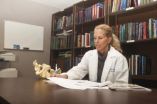The report is the third biennial evaluation of progress made by the Comprehensive Everglades Restoration Plan (CERP), a joint federal and state project that aims to reverse the ecosystem's decline while continuing to meet growing demands for clean water and flood control. Launched in 2000 by the U.S. Army Corps of Engineers and the South Florida Water Management District, CERP is a multiorganization planning process that comprises approximately 50 major projects to be completed over the next several decades.
"One of the main objectives in restoring the Everglades is 'getting the water right,' which calls for increasing the amount of freshwater that flows through the system while meeting water quality goals," said Frank Davis, chair of the committee that wrote the report and a professor at the Bren School of Environmental Science and Management at the University of California, Santa Barbara. "But, getting enough water to the right places at the right time and attaining water quality goals throughout the entire ecosystem is proving to be more difficult and expensive than originally anticipated. It will likely take several decades and a continued commitment to systemwide pollution management, storage, and water quality treatment."
After assessing the overall CERP and non-CERP efforts to restore the southern Florida ecosystem, the committee concluded that although progress has been slow over the past two years, improvements have been made in the pace of implementation, the relationship between federal and state partners, and research efforts. Four CERP projects are under construction, and pilot projects are addressing important design uncertainties. Several projects that serve as foundations to the plan are also under way, most notably the 1-mile Tamiami Trail bridge that is part of the Mod Waters project. However, only sparse natural system restoration benefits have resulted to date from the current construction.
The committee also found challenges for CERP in improving water flow and restoring water quality in the ecosystem. Although increasing water storage and associated water treatment is a major near-term priority, the reduced area and natural water storage capacity of the modern Everglades make evenly distributed restoration infeasible. Conditions may even worsen in some areas to achieve the desired outcomes in others.
The current extent of stormwater treatment areas (STAs) that remove phosphorus from the water is insufficient to treat existing water flow in the Everglades Protection Area, the report says. With increased volumes of water planned to enter the ecosystem as part of CERP, an estimated 54,000 additional acres of STAs would be required -- costing approximately $1.1 billion to construct and $27 million per year to operate and maintain. Therefore, the committee recommended a comprehensive cost-effectiveness analysis to optimize restoration outcomes given state and federal financial constraints. The committee also suggested research to assess STA sustainability and performance and improve practices that help control phosphorus and other nutrients. In addition, the River of Grass initiative, which includes the purchase of nearly 27,000 acres from U.S. Sugar, could provide additional land for water storage and treatment.
To help officials weigh the effects of simultaneous restoration projects on multiple ecosystem components, the report calls for research on the associated trade-offs from a whole ecosystem perspective, in particular the consequences of reducing water quantities while maintaining sufficient water quality and, conversely, reducing the quality of water in the ecosystem while maintaining sufficient flow. Furthermore, research should explore the degree to which negative consequences of these actions are reversible and on what time frames. Improved tools to help officials analyze decisions are needed to weigh the effects of restoration projects on multiple ecosystem components, including habitat conditions, threatened species, and features such as tree islands.
###
The report was sponsored by the U.S. Army Corps of Engineers, South Florida Water Management District, and U.S. Department of the Interior. The National Academy of Sciences, National Academy of Engineering, Institute of Medicine, and National Research Council make up the National Academies. They are independent, nonprofit institutions that provide science, technology, and health policy advice under an 1863 congressional charter. Committee members, who serve pro bono as volunteers, are chosen by the Academies for each study based on their expertise and experience and must satisfy the Academies' conflict-of-interest standards. The resulting consensus reports undergo external peer review before completion. For more information, visit http://national-academies.org/studycommitteprocess.pdf. A committee roster follows.
Copies of PROGRESS TOWARD RESTORING THE EVERGLADES - THE THIRD BIENNIAL REVIEW, 2010 are available from the National Academies Press; tel. 202-334-3313 or 1-800-624-6242 or on the Internet at HTTP://WWW.NAP.EDU. Reporters may obtain a copy from the Office of News and Public Information (contacts listed below).
Contacts: Jennifer Walsh, Media Relations Officer
Luwam Yeibio, Media Relations Assistant
Office of News and Public Information
202-334-2138; e-mail
[ This news release and report are available at HTTP://NATIONAL-ACADEMIES.ORG ]
NATIONAL RESEARCH COUNCIL
Division on Earth and Life Studies
Water Science and Technology Board
COMMITTEE ON THE INDEPENDENT SCIENTIFIC REVIEW OF EVERGLADES RESTORATION PROGRESS
FRANK W. DAVIS (CHAIR)
Professor
Donald Bren School of Environmental Science and
Management
University of California
Santa Barbara
STEVEN R. BEISSINGER
A. Starker Leopold Chair of Wildlife Biology, and
Professor
Division of Ecosystems Sciences
Department of Environmental Science, Policy, and
Management
University of California
Berkeley
WILLIAM G. BOGGESS
Professor and Associate Dean
College of Agricultural Sciences
Oregon State University
Corvallis
CHARLES T. DRISCOLL JR. *
University Professor
Department of Civil and Environmental Engineering
Syracuse University
Syracuse, N.Y.
JOAN G. EHRENFELD
Professor
Department of Ecology, Evolution, and Natural Resources
Cook College
Rutgers University
New Brunswick, N.J.
WILLIAM L. GRAF
Foundation University Professor and Chair
Department of Geography
University of South Carolina
Columbia
WENDY D. GRAHAM
Carl S. Swisher Eminent Scholar in Water Resources
Department of Agricultural and Biological Engineering, and
Director
Water Institute
University of Florida
Gainesville
CHRIS T. HENDRICKSON
Duquesne Light Company Professor of Engineering, and
Head
Department of Civil and Environmental Engineering
Carnegie Mellon University
Pittsburgh
WILLIAM P. HORN
Partner
Birch, Horton, Bittner, and Cherot
Washington, D.C.
DAVID H. MOREAU
Professor
Departments of City and Regional Planning, and Environmental Sciences and Engineering
University of North Carolina
Chapel Hill
K. RAMESH REDDY
Graduate Research Professor and Chair
Department of Soil and Water Science
University of Florida
Gainesville
R. WAYNE W. SKAGGS *
William Neal Reynolds Distinguished University Professor
Department of Biological and Agricultural Engineering
North Carolina State University
Raleigh
ROBERT R. TWILLEY
Director of the Wetland Biogeochemistry Program, and
Professor
Department of Oceanography and Coastal Science
Louisiana State University and Agricultural and Mechanical College
Baton Rouge
RESEARCH COUNCIL STAFF
STEPHANIE JOHNSON
Study Director
* Member, National Academy of Engineering
END



